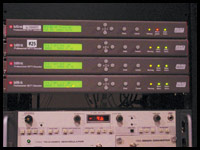Digital Vision’s BitLink at KAET-DT
Phoenix PBS station KAET- DT’s transition to digital terrestrial broadcasting necessitated an array of new equipment to facilitate reception, storage and transmission of digital programming. Following the station’s investigation of various technical solutions, it was determined that Digital Vision offered an integrated receiver/decoder (IRD) that would perform a number of critical broadcast functions, all within one box. The station currently uses the BitLink IRD for the main HD program and will shortly use IRDs for SD programs as well.

After its transition to digital, KAET-DT selected the BitLink IRD from Digital Vision to perform multiple broadcast functions for the station’s main HD program. It will soon use IRDs for SD programs as well.
A multifunction IRD
Before implementing the IRD, the station required more than one piece of equipment to receive and decode a single digital program feed from a satellite for recording and playout. In order to also handle the recording and transmission of EIA-708B closed captions and the second audio program (descriptive video service or Spanish), KAET-DT would have needed a more complicated system of equipment.
The IRD simplifies the situation to a large degree. Its flexible 1RU frame may be fitted and configured with up to six cards, giving the user many ways to configure the inputs and outputs. The station felt this design would lend itself to meeting future reconfiguration requirements.
IRD interfaces
The station’s program-rebroadcast needs dictate receiving satellite-relayed HD and SD programs pre-encoded at the PBS station in Alexandria, VA. The programs are then directly relayed to air or recorded for later broadcast. The IRD is configured for two inputs from the satellite LNBs on L band (vertical and horizontal antenna polarization). Output ASI interfaces are used for recording and downstream remapping to air, and decoded MPEG-2 video and AES audio program outputs are routed to conventional HD and SD VTRs for later playback. An internal frame synchronizer locked to the station’s 480i 59.94 house reference is included on HD and SD serial digital outputs, which eliminates the need for external synchronizers.
Get the TV Tech Newsletter
The professional video industry's #1 source for news, trends and product and tech information. Sign up below.
Multiple audio streams
PBS currently relays two Dolby Digital AC3-encoded audio streams with each HD and SD program: the main audio and the descriptive audio service or Spanish. Each stream will reappear on the station’s over-the-air DTV broadcast programs on audio PIDs.
To simplify the handling of multiple audio channels (up to 5.1) per audio stream and eliminate audio quality loss through needless decoding and re-encoding of the Dolby Digital (AC3), the IRD provides the option to bypass the audio decoding function and instead output both audio streams as Dolby Digital. KAET-DT took advantage of this feature to route both audio streams to their station encoder/multiplexer so that they might deliver maximum quality Dolby Digital audio to air with minimum complication and expense.
HD and SD closed captions
The IRD also handles and routes EIA-708B HD closed captions. Utilizing the SMPTE 334 standard to carry closed-caption data in the VANC of the HD-SDI stream, the station plans to record closed captions with its HD VTRs soon. It will also route the embedded EIA-708B closed captions to the HD encoder/multiplexer, where the data will be re-embedded into the HD MPEG video stream for broadcast.
Currently, closed captions are output as standard EIA-608 on line 21 of the SD-SDI interface and may be recorded and relayed to air as required.
Future uses
PBS digital program distribution will take other forms in the near future. Video and audio encoding at higher data rates (less compression) are an option. The IRD can decode HD MPEG-2 video encoded to 60Mb/s. KAET-DT also anticipates implementing Dolby-E pass-through when it’s available from PBS and when the situation demands it.
PBS also plans delivery of programs at non-real time via IP carriage of digitally compressed programs. PBS stations will be able to extract the IP program stream from the IRD via its ASI interface.
Software updates
With frequent new technical demands imposed on broadcast stations, broadcast engineering personnel need to periodically update the software in equipment. The BitLink IRD can be easily updated via its Ethernet connection. Digital Vision has rapidly attended to initial problems. Later software revisions activated new features, such as HD closed captions in the HD-SDI VANC and a widened synchronizer output-timing window to accommodate all HD and SD output timing preferences.
At a time of rapid technological change in the broadcast industry, the BitLink integrated receiver/decoder fulfills KAET’s need to future-proof all digital satellite reception processes.
Terry Harvey is chief broadcast engineer for KAET-TV and KAET-DT.
